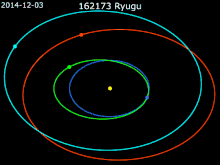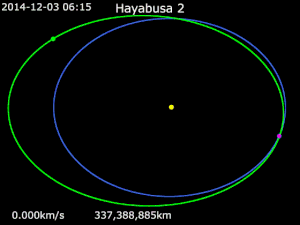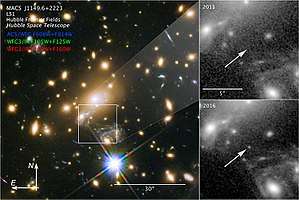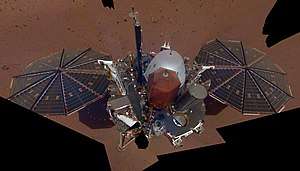162173 Ryugu
162173 Ryugu, provisional designation 1999 JU3, is a near-Earth object and a potentially hazardous asteroid of the Apollo group. It measures approximately 1 kilometer (0.6 mi) in diameter and is a dark object of the rare spectral type Cb,[12] with qualities of both a C-type asteroid and a B-type asteroid. In June 2018, a spacecraft, Hayabusa2, arrived at the asteroid.[13] After making measurements and taking samples, Hayabusa2 left Ryugu for Earth in November 2019.[14]
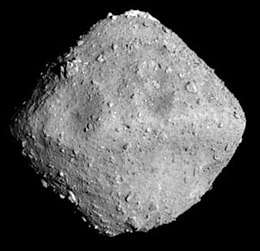 Monochrome view of Ryugu[lower-alpha 1] | |
| Discovery [1] | |
|---|---|
| Discovered by | LINEAR |
| Discovery site | Lincoln Lab's ETS |
| Discovery date | 10 May 1999 |
| Designations | |
| (162173) Ryugu | |
| Pronunciation | /riˈuːɡuː/ Japanese: [ɾjɯːɡɯː] |
Named after | Ryūgū [1] ("Dragon palace") |
| 1999 JU3 | |
| Apollo · NEO · PHA [1][2] | |
| Orbital characteristics [2] | |
| Epoch 12 December 2011 (JD 2455907.5) | |
| Uncertainty parameter 0 | |
| Observation arc | 30.32 yr (11,075 d) |
| Aphelion | 1.4159 AU |
| Perihelion | 0.9633 AU |
| 1.1896 AU | |
| Eccentricity | 0.1902 |
| 1.30 yr (474 d) | |
| 3.9832° | |
| 0° 45m 34.56s / day | |
| Inclination | 5.8837° |
| 251.62° | |
| 211.43° | |
| Earth MOID | 0.0006 AU (0.2337 LD) |
| Physical characteristics | |
Mean diameter | 0.865±0.015 km[3] 0.87 km[4] 0.90±0.14 km[5] 0.92±0.12 km[6] 0.980±0.029 km[7] 1.13±0.03 km[8] |
| Volume | 0.377±0.005 km3[9] |
| Mass | (4.50±0.06)×1011 kg[10][9] |
Mean density | 1.19±0.03 g cm−3[9] |
Equatorial surface gravity | 1/80,000 g[10] |
| 7.627±0.007 h[7][11] | |
| 0.037±0.002[7] 0.042±0.003[8] 0.047±0.003[3] 0.063±0.020[6] 0.07±0.01[5] 0.078±0.013[4] | |
| SMASS = Cg [2] · C [3] · Cb[12] | |
| 18.69±0.07 (R)[4] 18.82[6] 19.2[7] 19.25±0.03[3] 19.3[1][2] | |
History
Discovery and name
Ryugu was discovered on 10 May 1999 by astronomers with the Lincoln Near-Earth Asteroid Research at the Lincoln Lab's ETS near Socorro, New Mexico, in the United States. It was given the provisional designation 1999 JU3.[1] The asteroid was officially named "Ryugu" by the Minor Planet Center on 28 September 2015 (M.P.C. 95804).[15] The name refers to Ryūgū (Dragon Palace), a magical underwater palace in a Japanese folktale. In the story, the fisherman Urashima Tarō travels to the palace on the back of a turtle, and when he returns, he carries with him a mysterious box, much like Hayabusa2 returning with samples.[1][16]
Geological history
Possible surface samples will help to reveal the geological history of the asteroid.[18] There exists already a rough picture of the geological past of Ryugu, even before the samples arrived.
Ryugu formed as part of an asteroid family, belonging either to Eulalia or Polana.[18] Those asteroid families are likely fragments of past asteroid collisions. The large number of boulders on the surface supports a catastrophic disruption of the parent body.[19] The parent body of Ryugu likely experienced dehydration due to internal heating[18] and must have formed in an environment without a strong magnetic field.[20] After this catastrophic disruption part of the surface was reshaped again by the high speed rotation of the asteroid, forming the equatorial ridge (Ryujin Dorsum). Only the western bulge remained as an older structure.[21]
Characteristics
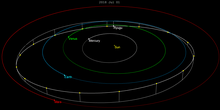
Orbit
Ryugu orbits the Sun at a distance of 0.96–1.41 au once every 16 months (474 days; semi-major axis of 1.19 au). Its orbit has an eccentricity of 0.19 and an inclination of 6° with respect to the ecliptic.[2] It has a minimum orbital intersection distance with Earth of 95,400 km (0.000638 au), equivalent to 0.23 lunar distances.[2]
Physical
Early analysis in 2012 by Thomas G. Müller et al. used data from a number of observatories, and suggested that the asteroid was "almost spherical", a fact that hinders precise conclusions, with retrograde rotation, an effective diameter of 0.85–0.88 kilometers, (0.528 miles) and a geometric albedo of 0.044 to 0.050. They estimated that the grain sizes of its surface materials are between 1 and 10 mm.[3]
Initial images taken by the Hayabusa2 spacecraft on approach at a distance of 700 km (430 mi) were released on 14 June 2018. They revealed a diamond shaped body and confirmed its retrograde rotation.[22] Between 17 and 18 June 2018, Hayabusa2 went from 330 to 240 km (210 to 150 mi) from Ryugu and captured a series of additional images from the closer approach.[23] Astronomer Brian May created stereoscopic images from data collected a few days later.[24] After a few months of exploration, JAXA scientists concluded that Ryugu is actually a rubble pile with about 50% of its volume being empty space.[25]
The acceleration due to gravity at the equator has been evaluated at about 0.11 mm/s2, rising to 0.15 mm/s2 at the poles. The mass of Ryugu is estimated at about 450 million tons.[26] The asteroid has a volume of 0.377 ± 0.005 km3 and a bulk density of 1.19 ± 0.03 g/cm3 based on the shape-model.[9]
Shape
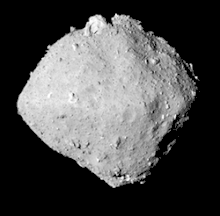
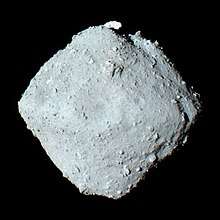
Ryugu has a round shape with an equatorial ridge, called Ryujin Dorsum. Ryugu is a spinning top-shape asteroid similar to Bennu. The ridge is shaped by strong centrifugal forces. The western side has a different shape compared to the rest of the asteroid. The western side, also called the western bulge has a smooth surface with a sharp equatorial ridge. The models showed that subsurface material is structural intact and relaxed in the western bulge, while other regions are more sensitive to structural failure.[21] The eastern and western side of Ryugu are bordered by the Tokoyo and Horai Fossae. The structural differences are due to structural changes in the history of the asteroids. Landslides and internal alternations reshaped the asteroid during a phase of high speed rotation. The western bulge is the region that was not affected by these reshaping forces.[27]
Surface
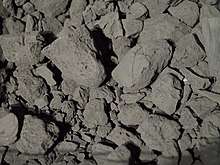
Observations from Hayabusa 2 showed that the surface of Ryugu is very young and has an age of 8.9 ± 2.5 Million years based on the data collected from the artificial crater that was created with an explosive by Hayabusa 2.[12][28]
The surface of Ryugu is porous and contains no or very little dust. The measurements with the radiometer on board of MASCOT, which is called MARA, showed a low thermal conductivity of the boulders. This was an in situ measurement of the high porosity of the boulder material. This result showed that most meteorites originating from C-type asteroids are too fragile to survive the entry into earths atmosphere.[29][30] The images from the camera of MASCOT, which is called MASCam, showed that surface of Ryugu contains two different almost black types of rock with little internal cohesion, but no dust was detected. One type of rocky material on the surface is brighter with a smooth surface and sharp edges. The other type of rock is dark with a cauliflower-like, crumbly surface. The dark type of rock has a dark matrix with small, bright, spectrally different inclusions. The inclusions appear similar to CI chondrites.[31][32] An unanticipated side effect from the Hyabusa 2 thrusters revealed a coating of dark, fine-grained red material.[33]
Craters
Ryugu has 77 craters on the surface. Ryugu shows variations of crater density that cannot be explained by randomness of cratering. There are more craters at lower latitudes and fewer at higher latitudes, and fewer craters in the western bulge (160°E - 290°E) than in the region around the meridian (300°E - 30°E). This variation is seen as evidence of a complicated geologic history of Ryugu.[34] The surface has one artificial crater, which was intentionally formed by the Small Carry-on Impactor (SCI), which was deployed by Hayabusa 2. SCI fired a 2 kg copper mass onto the surface of Ryugu on 2019-04-05.[35] The artificial crater showed a darker sub-surface material. It created an ejecta of 1 cm thickness and excavated material from up to 1 meter depth.[36]
Boulders
Ryugu contains 4400 boulders with a size larger than 5 meters. Ryugu has more large boulders per surface area than Itokawa or Bennu, about one boulder larger than 20 meters per 50 km2. The boulders resemble laboratory impact fragments. The high number of boulders is explained with a catastrophic disruption of Ryugu's larger parent body. The largest boulder, called Otohime has a size of ~160 × 120 × 70 m and is too large to be explained with an ejected boulder from a crater.[19]
Magnetic field
No magnetic field was detected near Ryugu on a global or local scale. This measurement is based on the magnetometer on board of MASCOT, which is called MasMag. This shows that Ryugu and the bodies it was created from did not generate a magnetic field and that they were not generated in an environment with a strong magnetic field. This result cannot be generalized for C-type asteroids, because the surface of Ryugu was recreated in a catastrophic disruption.[20]
Surface features
As of August 2019, there are 13 surface features that are named by the IAU.[37][38] The three landing sites are not officially confirmed but are referred to by specific names in media by JAXA. The theme of features on Ryugu is "children's stories." Ryugu was the first object to introduce the feature type known as the Saxum, referring to the large boulders found on Ryugu's surface.
Craters
| Feature | Named after |
|---|---|
| Brabo | Silvius Brabo[39] |
| Cendrillon | Cendrillon |
| Kibidango | Kibi dango featured in Momotaro |
| Kintaro | Kintaro |
| Kolobok | Kolobok |
| Momotaro | Momotaro |
| Urashima | Urashima Taro |
Dorsa
A dorsum is a ridge. There is a single dorsum on Ryugu.
| Feature | Named after |
|---|---|
| Ryujin Dorsum | Ryujin |
Saxa
A saxum is a large boulder. Ryugu is the first astronomical object with them being named. Two boulders have been named "Styx" and "Small Styx" unofficially by the JAXA team, it is unknown if these names will be submitted for IAU approval. Both names refer to the River Styx.[40]
| Feature | Named after |
|---|---|
| Catafo Saxum | Catafo, from Cajun folktales [38] |
| Ejima Saxum | Ejima, the location where Urashima Taro rescued the turtle [38] |
| Otohime Saxum | Otohime |
Landing sites
JAXA has given informal names to the specific landing and collection sites.
| Feature | Named after | Notes |
|---|---|---|
| Alice's Wonderland | Alice in Wonderland | MASCOT landing site |
| Tritonis | Lake Tritonis | MINERVA-II1 landing site, initially referred to as "Trinitas," as of February 2019 this has been rectified. |
| Tamatebako | Tamatebako | Site of first sample collection |
| Uchide-no-Kozuchi | Uchide no kozuchi | Site of second sample collection |
Hayabusa2 mission
The Japan Aerospace Exploration Agency (JAXA) spacecraft Hayabusa2 was launched in December 2014 and successfully arrived at the asteroid on 27 June 2018. It is planned to return material from the asteroid to Earth by December 2020.[41]
The Hayabusa2 mission includes four rovers with various scientific instruments. The rovers are named HIBOU (aka Rover-1A), OWL (aka Rover-1B), MASCOT and Rover-2 (aka MINERVA-II-2). On 21 September 2018, the first two of these rovers, HIBOU and OWL (together the MINERVA-II-1 rovers) which hop around the surface of the asteroid, were released from Hayabusa2.[42] This marks the first time a mission has completed a successful landing on a fast-moving asteroid body.[43]
On 3 October 2018, the German-French Mobile Asteroid Surface Scout (MASCOT) lander successfully arrived on Ryugu, 10 days after the MINERVA rovers landed.[44] Its mission was short-lived, as was planned (the device had no way to charge its batteries, instead relying by design on pre-charged batteries), with only 16 hours available from its batteries.
Hayabusa2 touched down briefly on February 22, 2019 on Ryugu, fired a small tantalum projectile into the surface to collect the cloud of surface debris within the sampling horn, and then it moved back to its holding position.[45] The second sampling was from the sub-surface, and it involved firing a large copper projectile from 500 m altitude to expose pristine material, and after several weeks, it touched down on 11 July 2019 to sample the sub-surface material, using its sampler horn and tantalum bullet.[46]
The last rover, Rover-2 or MINERVA-II-2, failed before release from the Hayabusa2 orbiter. It was deployed anyway on 2 October 2019 in orbit around Ryugu to perform gravitational measurements. It impacted the asteroid a few days after release.
On 13 November 2019, commands were sent to Hayabusa2 to leave Ryugu and begin its journey back to Earth.[14]
References
Notes
- Photograph of the full disc of 162173 Ryugu by the Optical Navigation Camera – Telescopic (ONC-T) instrument aboard the Hayabusa2 spacecraft. The photograph was taken on 26 June 2018, at a distance of 20 kilometres (12 miles) from the asteroid's surface.
Citations
- "162173 Ryugu (1999 JU3)". Minor Planet Center. Retrieved 30 October 2018.
- "JPL Small-Body Database Browser: 162173 Ryugu (1999 JU3)" (2016-08-09 last obs.). Jet Propulsion Laboratory. Retrieved 30 October 2018.
- Müller, T. G.; Durech, J.; Ishiguro, M.; Mueller, M.; Krühler, T.; Yang, H.; et al. (March 2017). "Hayabusa-2 mission target asteroid 162173 Ryugu (1999 JU3): Searching for the object's spin-axis orientation". Astronomy and Astrophysics. 599: 25. arXiv:1611.05625. Bibcode:2017A&A...599A.103M. doi:10.1051/0004-6361/201629134.
- Kim, Myung-Jin; Choi, Young-Jun; Moon, Hong-Kyu; Ishiguro, Masateru; Mottola, Stefano; Kaplan, Murat; et al. (February 2013). "Optical observations of NEA 162173 (1999 JU3) during the 2011-2012 apparition". Astronomy and Astrophysics. 550: 4. arXiv:1302.4542. Bibcode:2013A&A...550L..11K. doi:10.1051/0004-6361/201220673.
- Campins, H.; Emery, J. P.; Kelley, M.; Fernández, Y.; Licandro, J.; Delbó, M.; et al. (August 2009). "Spitzer observations of spacecraft target 162173 (1999 JU3)". Astronomy and Astrophysics. 503 (2): L17–L20. arXiv:0908.0796. Bibcode:2009A&A...503L..17C. doi:10.1051/0004-6361/200912374.
- Hasegawa, S.; Müller, T. G.; Kawakami, K.; Kasuga, T.; Wada, T.; Ita, Y.; et al. (December 2008). "Albedo, Size, and Surface Characteristics of Hayabusa-2 Sample-Return Target 162173 1999 JU3 from AKARI and Subaru Observations". Publications of the Astronomical Society of Japan. 60 (SP2): S399––S405. Bibcode:2008PASJ...60S.399H. doi:10.1093/pasj/60.sp2.S399.
- Abe, M.; Kawakami, K.; Hasegawa, S.; Kuroda, D.; Yoshikawa, M.; Kasuga, T.; et al. (March 2008). "Ground-based Observational Campaign for Asteroid 162173 1999 JU3" (PDF). Lunar and Planetary Science (1391): 1594. Bibcode:2008LPI....39.1594A. Retrieved 30 October 2018.
- Yu, Liang-Liang; Ji, Jiang-Hui; Wang, Su (July 2014). "Investigation of Thermal Inertia and Surface Properties for Near-earth Asteroid (162173) 1999 JU3". Chinese Astronomy and Astrophysics. 38 (3): 317–329. arXiv:1805.05244. Bibcode:2014ChA&A..38..317L. doi:10.1016/j.chinastron.2014.07.008.
- Watanabe, S.; Hirabayashi, M.; Hirata, N.; Hirata, N.; Shimaki, Y.; Ikeda, H.; Tatsumi, E.; Yoshikawa, M.; Kikuchi, S.; Yabuta, H.; Nakamura, T. (March 2019). "High Porosity Nature of the Top-Shape C-Type Asteroid 162173 Ryugu as Observed by Hayabusa2". LPI (2132): 1265. Bibcode:2019LPI....50.1265W.
- Clark, Stephen (6 September 2018). "Hayabusa 2 team sets dates for asteroid landings – Spaceflight Now". spaceflightnow.com. Retrieved 7 September 2018.
- "LCDB Data for (162173) Ryugu". Asteroid Lightcurve Database (LCDB). Retrieved 30 October 2018.
- Sugita, S.; Honda, R.; Morota, T.; Kameda, S.; Sawada, H.; Tatsumi, E.; Honda, C.; Yokota, Y.; Yamada, M.; Kouyama, T.; Sakatani, N. (July 2019). "Ryugu's Parent-Body Processes Estimated from Hayabusa2 Multi-Band Optical Observations". LPICo. 82 (2157): 6366. Bibcode:2019LPICo2157.6366S. ISSN 0161-5297.
- Chang, Kenneth; Stirone, Shannon (19 March 2019). "The Asteroid Was Shooting Rocks Into Space. 'Were We Safe in Orbit?' - NASA's Osiris-Rex and Japan's Hayabusa2 spacecraft reached the space rocks they are surveying last year, and scientists from both teams announced early findings on Tuesday (03/19/2019)". The New York Times. Retrieved 21 March 2019.
- https://spaceflightnow.com/2019/11/13/japanese-sample-return-craft-departs-asteroid-heads-for-earth/
- "MPC/MPO/MPS Archive". Minor Planet Center. Retrieved 30 October 2018.
- "Name Selection of Asteroid 1999 JU3 Target of the Asteroid Explorer "Hayabusa2"" (Press release). JAXA. 5 October 2015. Retrieved 30 October 2018.
- S. Sugita; et al. (19 March 2019). "The geomorphology, color, and thermal properties of Ryugu: Implications for parent-body processes". Science. 364 (6437): eaaw0422. doi:10.1126/science.aaw0422. hdl:1893/29363. PMID 30890587.
- Sugita, S.; Honda, R.; Morota, T.; Kameda, S.; Honda, C.; Yokota, Y.; Yamada, M.; Kouyama, T.; Sakatani, N.; Suzuki, H.; Yoshioka, K. (March 2019). "The Evolution of Ryugu's Parent Body Constrained by Hayabusa2 Imaging Observations". LPI (2132): 2622. Bibcode:2019LPI....50.2622S.
- Michikami, Tatsuhiro; Honda, Chikatoshi; Miyamoto, Hideaki; Hirabayashi, Masatoshi; Hagermann, Axel; Irie, Terunori; Nomura, Keita; Ernst, Carolyn M.; Kawamura, Masaki; Sugimoto, Kiichi; Tatsumi, Eri (October 2019). "Boulder size and shape distributions on asteroid Ryugu". Icar. 331: 179–191. Bibcode:2019Icar..331..179M. doi:10.1016/j.icarus.2019.05.019. ISSN 0019-1035.
- Hercik, David; Auster, Hans-Ulrich; Constantinescu, Dragos; Blum, Jürgen; Fornaçon, Karl-Heinz; Fujimoto, Masaki; Gebauer, Kathrin; Grundmann, Jan-Thimo; Güttler, Carsten; Hillenmaier, Olaf; Ho, Tra-Mi (2020). "Magnetic Properties of Asteroid (162173) Ryugu". Journal of Geophysical Research: Planets. 125 (1): e2019JE006035. doi:10.1029/2019JE006035. ISSN 2169-9100.
- Hirabayashi, Masatoshi; Tatsumi, Eri; Miyamoto, Hideaki; Komatsu, Goro; Sugita, Seiji; Watanabe, Sei-ichiro; Scheeres, Daniel J.; Barnouin, Olivier S.; Michel, Patrick; Honda, Chikatoshi; Michikami, Tatsuhiro (March 2019). "The Western Bulge of 162173 Ryugu Formed as a Result of a Rotationally Driven Deformation Process". Astrophysical Journal Letters. 874 (1): L10. arXiv:1904.03480. Bibcode:2019ApJ...874L..10H. doi:10.3847/2041-8213/ab0e8b. ISSN 0004-637X.
- "From a distance of about 700km, Ryugu's rotation was observed". JAXA. 16 June 2016. Retrieved 30 October 2018.
- Plait, Phil (20 June 2018). "Asteroid Ryugu Starts to Come Into Focus". SyFy Wire. Retrieved 30 October 2018.
- Bartels, Meghan (10 July 2018). "Queen's Brian May Will Rock You with This Stereo Image of Asteroid Ryugu". Space.com. Retrieved 24 December 2018.
- Hayabusa-2: Asteroid mission exploring a 'rubble pile'. Paul Rincon, BBC News. 19 March 2019.
- Operation status for the asteroid explorer, Hayabusa2, in the vicinity of Ryugu (PDF), JAXA, 5 September 2018, retrieved 30 October 2018
- "May 13, 2019. What's new". JAXA Hayabusa2 project (in Japanese). Retrieved 9 March 2020.
- Arakawa, M.; Saiki, T.; Wada, K.; Ogawa, K.; Kadono, T.; Shirai, K.; Sawada, H.; Ishibashi, K.; Honda, R.; Sakatani, N.; Iijima, Y. (19 March 2020). "An artificial impact on the asteroid 162173 Ryugu formed a crater in the gravity-dominated regime". Science. doi:10.1126/science.aaz1701. ISSN 0036-8075.
- "DLR - MASCOT confirms what scientists have long suspected". DLRARTICLE DLR Portal. Retrieved 7 March 2020.
- Grott, M.; Knollenberg, J.; Hamm, M.; Ogawa, K.; Jaumann, R.; Otto, K. A.; Delbo, M.; Michel, P.; Biele, J.; Neumann, W.; Knapmeyer, M. (15 July 2019). "Low thermal conductivity boulder with high porosity identified on C-type asteroid (162173) Ryugu". Nature Astronomy. 3 (11): 971–976. doi:10.1038/s41550-019-0832-x. ISSN 2397-3366.
- Jaumann, R.; Schmitz, N.; Ho, T.-M.; Schröder, S. E.; Otto, K. A.; Stephan, K.; Elgner, S.; Krohn, K.; Preusker, F.; Scholten, F.; Biele, J. (23 August 2019). "Images from the surface of asteroid Ryugu show rocks similar to carbonaceous chondrite meteorites". Science. 365 (6455): 817–820. doi:10.1126/science.aaw8627. ISSN 0036-8075. PMID 31439797.
- "The near-Earth asteroid Ryugu – a fragile cosmic rubble pile". DLRARTICLE DLR Portal. Retrieved 7 March 2020.
- "Hayabusa-2 Reveals Surface of Near-Earth Asteroid Ryugu in Stunning Detail". Sci News. 11 May 2020. Retrieved 12 May 2020.
- Hirata, Naoyuki; Morota, Tomokatsu; Cho, Yuichiro; Kanamaru, Masanori; Watanabe, Sei-ichiro; Sugita, Seiji; Hirata, Naru; Yamamoto, Yukio; Noguchi, Rina; Shimaki, Yuri; Tatsumi, Eri (March 2020). "The spatial distribution of impact craters on Ryugu". Icar. 338: 113527. Bibcode:2020Icar..33813527H. doi:10.1016/j.icarus.2019.113527. ISSN 0019-1035.
- "Apr. 24, 2019. What's new". JAXA Hayabusa2 project (in Japanese). Retrieved 9 March 2020.
- "Asteroid explorer, Hayabusa2, reporter briefing" (PDF). JAXA Hayabusa2 Project. 25 June 2019. Retrieved 9 March 2020.
- Jason Davis Hayabusa2 team sets date for sample collection, considers two touchdown sites Planetary.org January 16, 2019
- http://www.hayabusa2.jaxa.jp/en/topics/20190121e_Nomenclature/
- "Jan. 21, 2019. What's new". JAXA Hayabusa2 project (in Japanese). Retrieved 7 September 2019.
The brave young man who defeated a giant
- "July 8, 2019. What's new". JAXA Hayabusa2 project (in Japanese). Retrieved 7 September 2019.
- "Current status of the asteroid explorer, Hayabusa2, leading up to arrival at asteroid Ryugu in 2018" (PDF). JAXA. 14 June 2016. Retrieved 30 October 2018.
- Wall, Mike (21 September 2018). "Japanese Probe Deploys Tiny Hopping Robots Toward Big Asteroid Ryugu". space.com. Retrieved 30 October 2018.
- Yoshimitsu, Tetsuo; Kubota, Takashi; Tsuda, Yuichi; Yoshikawa, Makoto (23 September 2015). "MINERVA-II1: Successful image capture, landing on Ryugu and hop!". JAXA Hayabusa2 Project. JAXA. Retrieved 30 October 2018.
- "Touchdown! Japan space probe lands new robot on asteroid". phys.org. 3 October 2018. Retrieved 30 October 2018.
- Touchdown: Japan probe Hayabusa2 lands on distant asteroid. Kyoko Hasegawa, PhysOrg. February 22, 2019.
- "Hayabusa2 successfully collects 1st-ever subsurface samples: JAXA". Kyodo News. 11 July 2019. Retrieved 15 July 2019.
Bibliography
- Vilas, F. (2008). "Spectral Characteristics of Hayabusa 2 Near-Earth Asteroid Targets 162173 1999 Ju3 and 2001 Qc34". Astronomical Journal. 135 (4): 1101–1105. Bibcode:2008AJ....135.1101V. doi:10.1088/0004-6256/135/4/1101.
- "International Symposium Marco Polo and other Small Body Sample Return Missions: Programme and Presentations". European Space Agency. 18–20 May 2009.
- Moskovitz, Nicholas A.; Abe, Shinsuke; Pan, Kang-Shian; Osip, David J.; Pefkou, Dimitra; Melita, Mario D.; et al. (May 2013). "Rotational characterization of Hayabusa II target Asteroid (162173) 1999 JU3". Icarus. 224 (1): 24–31. arXiv:1302.1199. Bibcode:2013Icar..224...24M. doi:10.1016/j.icarus.2013.02.009.
External links
| Wikimedia Commons has media related to (162173) Ryugu. |
- 162173 Ryugu at NeoDyS-2, Near Earth Objects—Dynamic Site
- Ephemeris · Obs prediction · Orbital info · MOID · Proper elements · Obs info · Close · Physical info · NEOCC
- 162173 Ryugu at the JPL Small-Body Database
- MASCOT related publications by the Institute of Planetary Research contains related images and 3D models of the surface of Ryugu
